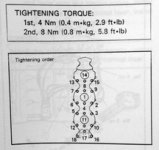Bigfish92084
New member
This has been happening for awhile and it seems only to happen when going 4500 rpm or higher.
I can run at 3500 and alarm never sounds. I just spent $1000 dollars at the dealership where they put in a new impeller, water pump & 2 new thermostats.
Still happening. I shot video this time and noticed the psi gauge is definitely loosing pressure when up on plane. I took heat readings from each cylinder side and noticed the port side was 10 degrees warmer. The motor was peeing out the side just fine. In my research on this forum I stumbled upon this previous post. I have PM the original post member hoping he can elaborate on this fix. The post was done 5 years ago so I am reaching out to anyone else who would be willing to help. My last trip out, even at 3500 rpm the alarm went off but took awhile. When I do WOT, it alarms within a minute.
I'm going nuts trying to figure this out and the so-called $100 per hour experts are not able to figure it out.
"I have recently struck a consession of Yamaha outboards with similar cocerns to yours. After replacing t/stat and water pumps, i found in all 4 cases, yes 4, that the water tube from the pump to the lower end of the power head, was corroded where is has the rubber grommet around it. It is nessesary to remove the g/box and lower leg to replace this pipe, but it is not a difficult nor time consuming repair.
Hope this may help."
I need more specifics on how to do this "remove the g/box and lower leg to replace this pipe".
Does the lower unit need to drop?
Is the g/box the black cover on the front side of motor?
What is the "lower leg"?
I can run at 3500 and alarm never sounds. I just spent $1000 dollars at the dealership where they put in a new impeller, water pump & 2 new thermostats.
Still happening. I shot video this time and noticed the psi gauge is definitely loosing pressure when up on plane. I took heat readings from each cylinder side and noticed the port side was 10 degrees warmer. The motor was peeing out the side just fine. In my research on this forum I stumbled upon this previous post. I have PM the original post member hoping he can elaborate on this fix. The post was done 5 years ago so I am reaching out to anyone else who would be willing to help. My last trip out, even at 3500 rpm the alarm went off but took awhile. When I do WOT, it alarms within a minute.
I'm going nuts trying to figure this out and the so-called $100 per hour experts are not able to figure it out.
"I have recently struck a consession of Yamaha outboards with similar cocerns to yours. After replacing t/stat and water pumps, i found in all 4 cases, yes 4, that the water tube from the pump to the lower end of the power head, was corroded where is has the rubber grommet around it. It is nessesary to remove the g/box and lower leg to replace this pipe, but it is not a difficult nor time consuming repair.
Hope this may help."
I need more specifics on how to do this "remove the g/box and lower leg to replace this pipe".
Does the lower unit need to drop?
Is the g/box the black cover on the front side of motor?
What is the "lower leg"?


